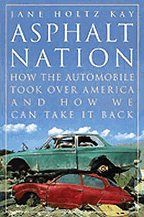Eight Myths of Traffic Planning
by Roger Baker
A growing number of planning experts realize that current trends in transportation are unsustainable. Like an addictive drug, a transportation policy oriented around the private automobile dictates urban policies in a way that can seem deceptively sensible.
In the short term, automobile-oriented land-use patterns encourage economic segregation into wealthy suburbs in conflict with a struggling core city economy. In the longer run, they slowly drag down the livability of the entire metropolitan area. Urban growth policies dictated by the automobile are gradually making many cities in the United States uncompetitive with other areas in the United States and in the larger global economy. Here are the contradictions that lie behind the comfortable myths used to justify a losing battle to keep up with the endless demands of the car:
MYTH 1: Traffic projections are important in deciding what roads are needed.
While such an assumption looks reasonable at first glance, such a computer-oriented projection of past trends assumes first that current trends are healthy, and second that present travel habits are worth projecting into the future. The computer models rarely if ever look at the side-effects of the projected roadway policies they justify. This myth is closely tied to myths 2 and 3.
MYTH 2: Planners are not responsible for how much people want to drive.
In every city of the world the volume of traffic is limited, intentionally or unintentionally, by government policies. For example, Houston residents use six times more gasoline than London residents and eight times more than Amsterdam residents. Past and current infrastructure policies affect current and future travel patterns and are subject to change. People don’t love their cars any more than politicians love to keep raising gas taxes to try to keep building roads to keep up with ever-increasing demand.
MYTH 3: Predicted traffic growth must be provided for.
In practice, there is a sort of Parkinson’s law that peak-hour traffic almost always expands to fill available road space. Bigger roads act like magnets to attract and generate traffic for the following reasons: First, new trip destinations are made practical. Second, the frequency of some trips increases because access becomes easier. Third, people take jobs farther from home. Fourth, some people shift from mass transit to private cars. Fifth, the reduction in mass transit ridership encourages land-use patterns oriented to car travel. Each increase in capacity ratchets up demand, attracts more traffic, and thus justifies further increases.
MYTH 4: Bigger roads are safer.
Since more and bigger roads generate their own increasing demand, the important consideration is per-capita roadway mortality. Yet the death toll keeps increasing despite decreasing mortality rates per mile because of more miles driven. Bigger roads also tend to encourage higher speeds and faster driving until the roads become as unsafe as ever. During the 1974 fuel crisis, speed limits were reduced with an estimated saving of 3,000 to 5,000 lives per year.
MYTH 5: Bigger roads increase mobility.
With bigger roads we are obliged to use more time to reach fewer and fewer destinations; we have to run faster to stand still. Bigger roads encourage sprawl and longer trips. Also, small, functioning communities are destroyed by roads so that local stores are replaced by big-box “category-killing” chain stores, shopping centers, etc. Each new car requires 30 times as much roadway space as the transit it replaces, encouraging low-density, high-cost suburban sprawl. Mobility should be redefined as being able to reach desired destinations rather than average speed or how far it is possible to travel.
MYTH 6: Bigger roads help more people than they disadvantage.
Clearly, an emphasis on automobile-related urban development disadvantages those without cars — in particular the poor, the elderly, the disabled, and children. In addition, heavier traffic disrupts local communities and small business viability and sprawl makes cities spend more per capita on infrastructure. The end result is that bigger roads disadvantage everyone and benefit only the narrow range of those who directly profit from roads and automobiles and are an inherently more expensive mode of land development.
MYTH 7: It is not the job of traffic planners to look at the wider social, political, and environmental trends implied by transportation policies.
Roadway planners and traffic engineers are trained to focus their attention solely on moving cars faster and farther. They are not taught to consider the results such as global warming and other subtle social, economic, and environmental side-effects of their policies. Planning that reacts to past needs is ill-equipped to respond to the patterns of the future. Not only do traffic engineers fail to focus on these current problems, but current policies fail to anticipate the real likelihood that oil shortages or economic downturns may have an unexpected but catastrophic effect on future mobility, as did the fuel crisis of the 1970s.
MYTH 8: Planning should be left to the experts.
The community should have an opportunity to undo past mistakes and shape the future. The most important questions that arise in urban policy are not matters of expertise, but rather the general goals of what the community should be like in 20 years.The choices and decisions should be determined by a well-informed public able to understand the implications of current policies and trends. The results are now all too often the hidden consequences of roadway policies implied to be inevitable using projections generated with a computer based on current trends.
Roger Baker is a long-time Austin, Texas-based transportation activist. He rewrote and edited these myths based on a broadsheet that has been making its way around the world on paper and the internet. You can contact him by email at:RCBaker(at)eden(dot)com
